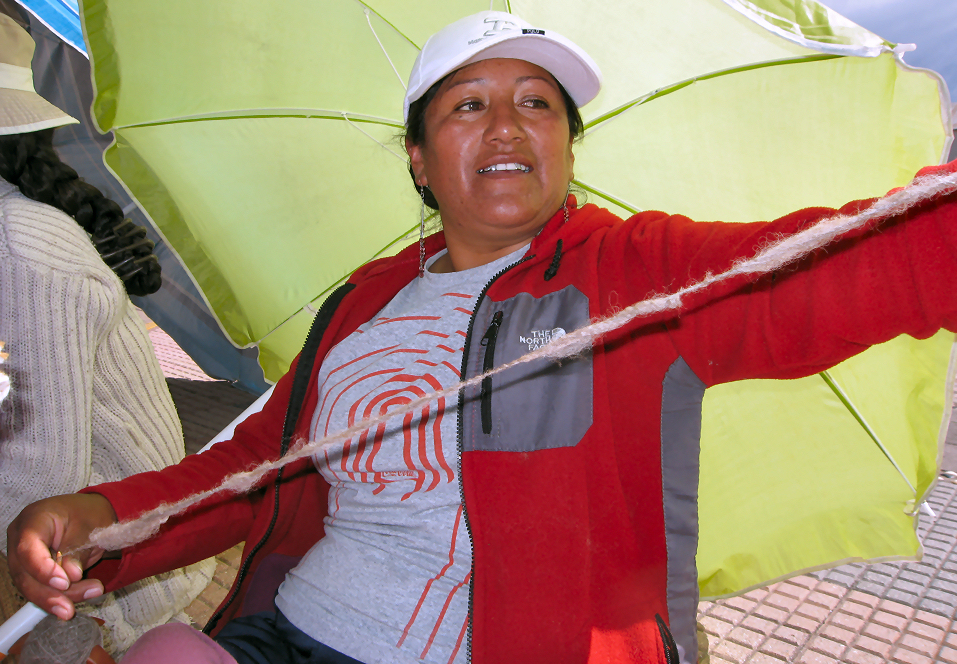Quest for Fiber:
Revisting Arequipa’s Fiber Mills
Last year, when I was in Arequipa, I wrote about my disappointment in trying to find natural alpaca fiber and yarn in the city that has several large fiber mills. This year, I made another attempt to explore Arequipa’s fiber and was a bit more rewarded for my efforts. However to find women (and men) working with yarn in a more traditional way, you must leave the big city and find your way up into the Andes mountains. More about that in another post—first, I want to report on my visits to two of the alpaca mills in Arequipa.
The first one is Michell’s Mill, the place where more tourists go because of their very interesting alpaca museum, Mundo Alpaca and high-end apparel shop located on the mill grounds. You can read more about this in my previous blog: Fiber: Chapter 2—Experiences with Alpaca and Acrylic. And there is a nice video about Mundo Alpaca here. Drops Designs is one on-line yarn store which contracts with Michell’s to create yarn for them.
| Above right, F/S Alpaca; lower right, Brushed alpaca and silk |
There is another outlet shop in Arequipa for the mill, Inka Tops, but my experience there was quite different. I ended up purchasing some yarn and I am not sure why. I learned about Inka Tops after doing some internet research and found their very interesting website. The part that intrigued me the most was the recent construction of their new “green” scouring and combing plant. Their solar pre-heated washing water is re-used and the solids are filtered out and put on the plant vegetable garden from which they harvest food for their employees! They also placed their fiber sorting station on the top floor with lots of natural light to make it easier for the classifiers to grade the fiber. You can read more about this innovative mill here. ) Cascade Yarns which is based in Seattle contracts with Inka Tops to make some of their yarn.
I had to make an appointment to visit the Inka Tops store and was put in contact with Elizabeth Herrera, a very nice and gracious company representative. Even though she knew that I was not a “big-client” possibility, she met with me and my friend Annie in their offices to show me the kind of yarn we would find in their store. I had to choose the yarn I wanted and then we walked down a few blocks to make our purchase. They also had some beautiful fiber and it took me a while to decide on some very, very fine 65% baby alpaca/35% linen. I had never heard of an alpaca/linen blend and was intrigued.
| Baby Alpaca and Linen–ONE KILO! |
| Some of the products created by the women of the Kalpaca project. |
Other Blog Posts You May Find Interesting

Quest for Fiber: Translating Tom Sawyer
Sitting there with no work reminded me of a very classic American story by Mark Twain. In very broken Spanish, I tried to recount Tom Sawyer’s method of snookering his friends into whitewashing the fence.

Quest for Fiber: Revisiting Arequipa’s Fiber Mills
Michell’s Mill is the place where more tourists go because of their very interesting alpaca museum, Mundo Alpaca and high-end apparel shop located on the mill grounds.

Quest for Fiber: Picky about my Hentilagets on Bressay
You find hentilagets where sheep have rubbed up against walls or fences, but the best pieces for spinning are on the ground. I found that most hentilagets are rubbish. They have been weathered too much and are slightly felted,
3 thoughts on “Quest for Fiber: Revisiting Arequipa’s Fiber Mills”
Looks like you found your way to Mecca!
Congratulations Baby and thanks for the fantastic reportage.
Your powerpoint Trees for Bees was beautiful, especially the last shot.
I hope it was fun to do.
Why don't you sell the yarn on etsy? You could create a story behind each type… could sell well
This comment has been removed by the author.